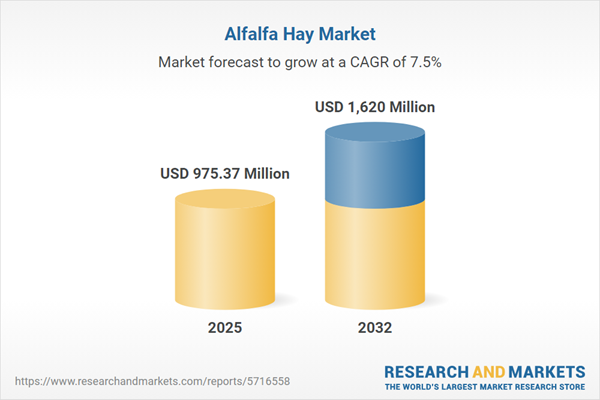Speak directly to the analyst to clarify any post sales queries you may have.
Senior decision-makers navigating the global alfalfa hay market face an environment shaped by accelerated regulatory changes, rising sustainability benchmarks, and evolving customer expectations. Staying ahead in this industry now requires access to independent analysis, reliable forecasting, and actionable insights that protect margins and build resilience amid intensifying complexity.
Market Snapshot: Alfalfa Hay Market Size and Growth Outlook
The global alfalfa hay market is projected to grow from USD 908.01 million in 2024 to USD 975.37 million by 2025, ultimately reaching USD 1.62 billion by 2032 at a 7.54% compound annual growth rate. Expansion is both broad-based and robust, supported by sustained demand for high-quality animal feed, rapid advances in agri-technology, and evolving regulatory frameworks across key markets. As digital technologies and precision farming practices gain traction, organizations are improving operational efficiency, achieving better traceability, and responding to compliance requirements in the animal feed segment.
Scope & Segmentation of the Alfalfa Hay Market
This report presents a segmentation framework designed for executive-level decision-making, supporting optimal investment, procurement, and operations across the evolving alfalfa hay value chain. Each area reflects distinct regulatory and market dynamics:
- Product Types: Focuses on both conventional and organic alfalfa hay types, emphasizing sustainable sourcing, adoption of environmental certifications, and responsible supply chain management that aligns with stakeholder expectations and regulatory mandates.
- Forms: Covers diverse bale formats such as large round, large square, and small square bales, as well as cubes and pellets—each format tailored for different livestock needs and production requirements to enable operational flexibility.
- End Users: Addresses the procurement strategies and product expectations of beef cattle operators requiring stable feed costs, dairy producers prioritizing efficiency, and equine facility managers seeking consistent quality to safeguard animal health.
- Distribution Channels: Includes direct producer supply, formal contract arrangements with feedlot operators, integration of digital marketplaces, and agricultural retailers—all supporting agility and diversification in sourcing.
- Regions Covered: Analyzes strategic markets in the Americas, Europe, Middle East and Africa, and Asia-Pacific, with special attention to how varying climates, infrastructure robustness, and regulatory regimes influence sourcing strategy and compliance management.
- Leading Companies: Profiles prominent suppliers including Cargill, Archer Daniels Midland, Land O’Lakes, Scoular Company, Wilbur-Ellis, Nutrien, Nutreco, and J.R. Simplot Company, evaluating their product portfolios, supply reliability, and ability to forge strategic partnerships in global markets.
Key Takeaways for Senior Decision-Makers
- Precision agriculture and digital adoption are enhancing forage quality, resource efficiency, and production planning, allowing firms to respond swiftly to shifting supply and demand conditions.
- Sustainability practices, such as regenerative agriculture, are growing in significance as a differentiator and are critical for compliance with more rigorous global and regional environmental regulations.
- Emerging specialty products, including high-protein pellets and advanced cubes, are opening new opportunities in the dairy and equine segments, where premium nutrition is a key selling point.
- Supply chain traceability and agility are strengthened by digital platforms, which support compliance oversight and effective risk management practices across operations and logistics.
- Procurement strategies are integrating robust logistics infrastructure and environmental due diligence processes, ensuring organizations can maintain reliable supply while adapting to evolving regulatory and market trends.
- Investment in advanced production technology helps organizations address variable customer demands and market volatility while maintaining consistent quality across international markets.
Tariff Impact and Competitive Landscape
Forthcoming changes in U.S. tariff frameworks are compelling alfalfa hay market participants to diversify sourcing channels and develop resilient business models. Exporters are broadening their ranges and implementing more stringent certification protocols to remain competitive. Concurrently, increased input costs are prompting accelerated technology adoption and innovative agricultural practices, which are becoming vital for maintaining cost efficiency and ensuring stability within both alfalfa hay and wider livestock feed markets.
Market Research Methodology & Data Sources
This research is underpinned by validated secondary sources, regulatory review, scholarly literature, and insights from recognized experts specializing in agronomy and supply chain management. Findings are independently modeled to align with executive decision-making needs and the unique structures of the alfalfa hay industry.
Why This Alfalfa Hay Market Report Matters
- Equips senior leaders with up-to-date market intelligence to refine strategy and proactively address regulatory changes in the alfalfa hay market.
- Enables executive teams to navigate sourcing complexities, optimize investment, and maintain compliance as technology adoption and sustainability continue to reshape the landscape.
- Provides forward-looking insights to strengthen risk management frameworks and ensure supply chain adaptability in line with customer and regulatory expectations.
Conclusion
This analysis empowers executives to address technological, regulatory, and strategic changes with confidence, supporting effective leadership and resilience in a dynamic global alfalfa hay market.
Additional Product Information:
- Purchase of this report includes 1 year online access with quarterly updates.
- This report can be updated on request. Please contact our Customer Experience team using the Ask a Question widget on our website.
Table of Contents
3. Executive Summary
4. Market Overview
7. Cumulative Impact of Artificial Intelligence 2025
Companies Mentioned
The companies profiled in this Alfalfa Hay market report include:- Cargill, Incorporated
- Archer Daniels Midland Company
- Land O'Lakes, Inc.
- Scoular Company
- Wilbur-Ellis Company
- Nutrien Ltd.
- Nutreco N.V.
- J. R. Simplot Company
Table Information
| Report Attribute | Details |
|---|---|
| No. of Pages | 187 |
| Published | November 2025 |
| Forecast Period | 2025 - 2032 |
| Estimated Market Value ( USD | $ 975.37 Million |
| Forecasted Market Value ( USD | $ 1620 Million |
| Compound Annual Growth Rate | 7.5% |
| Regions Covered | Global |
| No. of Companies Mentioned | 9 |









